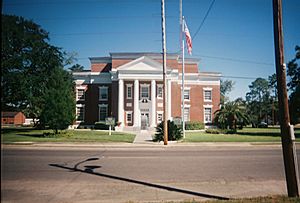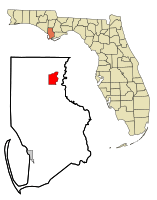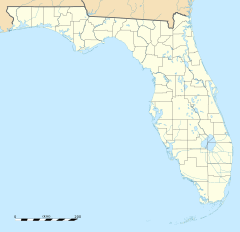Wewahitchka, Florida facts for kids
Quick facts for kids
Wewahitchka, Florida
|
|
|---|---|
| City of Wewahitchka | |

Old Gulf County Courthouse
|
|
| Motto(s):
"Home of Dead Lakes & Tupelo Honey"
|
|

Location in Gulf County and the state of Florida
|
|
| Country | |
| State | |
| County | Gulf |
| Settled | c. 1870-1875 |
| Incorporated | 1959 |
| Government | |
| • Type | Commission–Manager |
| Area | |
| • Total | 7.80 sq mi (20.20 km2) |
| • Land | 6.69 sq mi (17.34 km2) |
| • Water | 1.11 sq mi (2.87 km2) |
| Elevation | 46 ft (14 m) |
| Population
(2020)
|
|
| • Total | 2,074 |
| • Density | 309.88/sq mi (119.64/km2) |
| Time zone | UTC-6 (Central (CST)) |
| • Summer (DST) | UTC-5 (CDT) |
| ZIP Code |
32465
|
| Area code(s) | 850 |
| FIPS code | 12-77100 |
| GNIS feature ID | 0294641 |
Wewahitchka is a city in Gulf County, Florida, United States. The population was 2,074 as of the 2020 census. From the creation of Gulf County in 1925 until 1965, it served as the county seat before the county seat was moved to Port St. Joe. The City of Wewahitchka was settled around 1870 and officially founded in 1875. The city took its name from a Native American word meaning "water eyes". Two lakes along the edge of town look like a perfect pair of eyes, one of the lakes is called Lake Julia, while the other one is Lake Alice.
Geography
The approximate coordinates for the City of Wewahitchka is located in northeast Gulf County at 30°6′51″N 85°11′55″W / 30.11417°N 85.19861°W.
Wewahitchka is located in northeastern Gulf County at the junction of Florida State Roads 71 and 22. SR 71 leads north 27 miles (43 km) to Blountstown and south 24 miles (39 km) to Port St. Joe, while SR 22 leads west 28 miles (45 km) to Panama City.
According to the United States Census Bureau, Wewahitchka has a total area of 7.7 square miles (20.0 km2), of which 6.5 square miles (16.8 km2) is land and 1.2 square miles (3.2 km2), or 15.80%, is water.
It is located west of the Chipola River, a tributary of the Apalachicola River, and southwest of Dead Lakes. The two "eye-shaped" lakes from which the city takes its Native American names are Lake Julia and Lake Alice. And Lake Shippey is also located at the bottom center of the city limits.
Climate
The climate in this area is characterized by hot, humid summers and generally mild winters. According to the Köppen climate classification, the City of Wewahitchka has a humid subtropical climate zone (Cfa).
| Climate data for Wewahitchka, Florida, 1991–2020 normals, extremes 1901–present | |||||||||||||
|---|---|---|---|---|---|---|---|---|---|---|---|---|---|
| Month | Jan | Feb | Mar | Apr | May | Jun | Jul | Aug | Sep | Oct | Nov | Dec | Year |
| Record high °F (°C) | 85 (29) |
86 (30) |
93 (34) |
93 (34) |
99 (37) |
104 (40) |
105 (41) |
101 (38) |
99 (37) |
98 (37) |
93 (34) |
87 (31) |
105 (41) |
| Mean maximum °F (°C) | 76.9 (24.9) |
78.7 (25.9) |
83.2 (28.4) |
87.0 (30.6) |
92.5 (33.6) |
95.4 (35.2) |
95.8 (35.4) |
94.7 (34.8) |
93.1 (33.9) |
87.8 (31.0) |
83.7 (28.7) |
78.6 (25.9) |
97.4 (36.3) |
| Mean daily maximum °F (°C) | 63.1 (17.3) |
66.5 (19.2) |
72.2 (22.3) |
78.1 (25.6) |
84.9 (29.4) |
88.4 (31.3) |
89.4 (31.9) |
89.0 (31.7) |
86.1 (30.1) |
79.7 (26.5) |
71.5 (21.9) |
65.3 (18.5) |
77.9 (25.5) |
| Daily mean °F (°C) | 51.4 (10.8) |
54.9 (12.7) |
60.5 (15.8) |
66.2 (19.0) |
73.5 (23.1) |
78.8 (26.0) |
80.6 (27.0) |
80.4 (26.9) |
77.0 (25.0) |
68.7 (20.4) |
59.4 (15.2) |
53.8 (12.1) |
67.1 (19.5) |
| Mean daily minimum °F (°C) | 39.8 (4.3) |
43.3 (6.3) |
48.8 (9.3) |
54.3 (12.4) |
62.2 (16.8) |
69.1 (20.6) |
71.7 (22.1) |
71.7 (22.1) |
67.9 (19.9) |
57.7 (14.3) |
47.3 (8.5) |
42.4 (5.8) |
56.4 (13.5) |
| Mean minimum °F (°C) | 23.9 (−4.5) |
28.1 (−2.2) |
32.8 (0.4) |
40.5 (4.7) |
49.6 (9.8) |
62.0 (16.7) |
67.7 (19.8) |
66.7 (19.3) |
58.2 (14.6) |
42.0 (5.6) |
31.5 (−0.3) |
28.0 (−2.2) |
22.3 (−5.4) |
| Record low °F (°C) | 11 (−12) |
15 (−9) |
20 (−7) |
34 (1) |
35 (2) |
45 (7) |
56 (13) |
60 (16) |
41 (5) |
30 (−1) |
22 (−6) |
11 (−12) |
11 (−12) |
| Average precipitation inches (mm) | 4.83 (123) |
4.94 (125) |
5.26 (134) |
4.49 (114) |
3.28 (83) |
6.27 (159) |
8.24 (209) |
7.91 (201) |
6.63 (168) |
3.24 (82) |
3.84 (98) |
4.17 (106) |
63.10 (1,603) |
| Average precipitation days (≥ 0.01 in) | 9.0 | 8.6 | 7.4 | 7.1 | 6.7 | 13.4 | 16.7 | 16.5 | 11.2 | 6.3 | 6.7 | 8.3 | 117.9 |
| Source: NOAA | |||||||||||||
Demographics
| Historical population | |||
|---|---|---|---|
| Census | Pop. | %± | |
| 1930 | 584 | — | |
| 1940 | 1,022 | 75.0% | |
| 1950 | 1,289 | 26.1% | |
| 1960 | 1,436 | 11.4% | |
| 1970 | 1,733 | 20.7% | |
| 1980 | 1,742 | 0.5% | |
| 1990 | 1,779 | 2.1% | |
| 2000 | 1,722 | −3.2% | |
| 2010 | 1,981 | 15.0% | |
| 2020 | 2,074 | 4.7% | |
| U.S. Decennial Census | |||
2010 and 2020 census
| Race | Pop 2010 | Pop 2020 | % 2010 | % 2020 |
|---|---|---|---|---|
| White (NH) | 1,712 | 1,772 | 86.42% | 85.44% |
| Black or African American (NH) | 165 | 148 | 8.33% | 7.14% |
| Native American or Alaska Native (NH) | 11 | 18 | 0.56% | 0.87% |
| Asian (NH) | 1 | 4 | 0.05% | 0.19% |
| Pacific Islander or Native Hawaiian (NH) | 0 | 0 | 0.00% | 0.00% |
| Some other race (NH) | 1 | 1 | 0.05% | 0.05% |
| Two or more races/Multiracial (NH) | 52 | 96 | 2.62% | 4.63% |
| Hispanic or Latino (any race) | 39 | 35 | 1.97% | 1.69% |
| Total | 1,981 | 2,074 |
As of the 2020 United States census, there were 2,074 people, 797 households, and 534 families residing in the city.
As of the 2010 United States census, there were 1,981 people, 878 households, and 609 families residing in the city.
Schools
Wewahitchka is home to two schools of Gulf District Schools: Wewahitchka Elementary School and Wewahitchka High School, whose mascots are the Gators. There is a Head Start program at the old elementary site.
Tupelo honey
Wewahitchka is the site of one of Florida's largest beekeeping operations, which was the setting for Ulee's Gold, a movie filmed in the area. This honey is produced by placing beehives, known by the beekeepers as "Bee Boxes", in the swamps along the Apalachicola and other area rivers. In some areas the bees are placed on platforms and rafts to keep them above potential floods. Prior to the tupelo bloom, all earlier season honeys are stripped from the bees to avoid contamination with lesser grades produced earlier. Likewise, as soon as bloom is finished, the honey must be removed quickly before the bees have a chance to add other types of nectar. Wewahitchka has a two-day Tupelo Honey festival each May.
See also
 In Spanish: Wewahitchka para niños
In Spanish: Wewahitchka para niños



